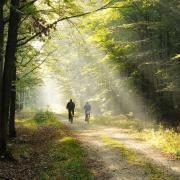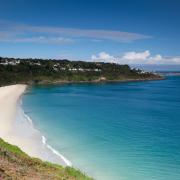James Churchfield, presenter of BBC Radio Cornwall's Breakfast Show, delves into Cornwall's ancient history
A Glimpse of our Past
James Churchfield, presenter of BBC Radio Cornwall’s Breakfast Show, delves into Cornwall’s ancient history
Men-an-Tol near Madron, Penzance
One of my favourite images of ancient Cornwall involves the Men-an-Tol. (pictured above.) The upturned circular stone with a hole in the middle, is one of ancient Britain’s best-known megalithic structures. They’re renowned for being a cure for all ailments, with patients supposedly ‘cured’ if they pass through the stone’s hole. Looking through the stone perhaps provides another idea as to its use, providing a viewfinder through which to see other features in the West Penwith landscape. Added to the Men-an-Tol’s mystery is its rarity. There’s only one other similarly sized prehistoric circle known to historians in Cornwall, near Gweek.
Carn Brae, Redruth
The site of one of the earliest settlements not just in Cornwall but also in the whole of Ancient Britain can be clearly seen today by motorists using the A30 near Redruth. Historians believe that Carn Brea, with its lofty view to the north Cornish coast, was once home to several rectangular lean-to structures that may well have been part of a hilltop enclosure. Excavations of the area have revealed evidence of the site’s intriguing if somewhat grim pre-Roman past. On a recent trip to the Royal Cornwall Museum in Truro I was astounded to see some 700 leaf shaped arrowheads on display. Far from providing evidence of the tools our ancestors would have used to catch their food, these weapons were apparently more likely to end up embedded in the skull or torso of a member of an enemy tribe. Such a find suggests that Carn Brea was a location highly prized for its strategic viewpoint, with the occupying tribe defending it to the death. Life must have been hard up there too. Even today when I’ve been walking up there, the mist can descend and make it a tough place to be.
Ancient facts
Across Cornwall flintwork finds have given us evidence of more than 500 hunter-gather sites.
People lived in roundhouses between 3,000BC and AD300 – a longer period of time than we have been living in square houses! There is evidence of more than 2,000 prehistoric round houses across Cornwall.
The oldest known man-made relics found in Cornwall are flint knives, which come from the upper Paleolithic period, somewhere between 8,000-6,000BC.
The remains of a giant Irish elk were washed out of the cliffs at Fistral Beach. From the position in the rocks it has been possible to tell that it lived in the warm period before the last glacial age. This means that it is around 100,000 years old.
During the construction of the Trispen bypass an Iron Age site was found. While there was significant evidence of metalworking, there was no sign of people living on the site, making Killigrew Round the oldest known industrial estate in Cornwall!
Castle-an-Dinas, near St Columb Major
One of the most visible parts of Iron Age Britain can be seen at Castle-an-Dinas – in fact I can virtually see it from my front door. The earthy embellishment, sat atop the gently rising hill, points to a style of hill fort commonly seen in the 4th century. The site is likely to have played a part in the life of the Dumnonii tribe, which held the balance of power in Iron Age Cornwall. There’s also evidence of two Bronze Age barrows upon which later structures and development may well have been placed. Today it is managed by the Cornwall Heritage Trust but as to what its role was back then, no one is quite sure.
When I’ve been up there in all weathers I could easily appreciate the strategic advantage any occupying tribe would have had from Castle-an-Dinas, with its clear view to the coast across unspoilt countryside. But archaeologists believe such areas were created more for spectacle or ritual rather than for a tactical purpose. Another theory is that the area could have been used as a settlement for livestock. Was there ever a castle here? Who knows – but I’m told by my neighbours that rocks from such a building were used to build the house I live in!
The Hurlers, Bodmin Moor
Bodmin Moor’s landscape provides plenty of evidence of how our ancestors used to live. The noted Cornish historian William Borlase first detailed the three stone circles that make up The Hurlers in 1754. Their mystical character is bound together by the notion of Godly revenge, with the boulders said to be men turned to stone for using bad language on the Sabbath. The Hurlers (below) date to the early Bronze Age, and not far away are amazing natural rocky outcrops, including the striking granite formation known as the Cheesewring. Whatever the weather, these formations have the power to render you quite speechless – even on a wet day when I last saw them.
Halliggye, Mawgan-in-Meneage
One of the rarest examples of our early existence in Cornwall can be seen in the curious cave-like structures dotted across the land. Known as fogous (above), these prehistoric underground passages were built by forming a trench, lining its sides with large stones or building walls, and then enclosing it with a roof made of huge, flat stones. One of the best examples of these can be found at Halliggye, tucked away on the Trelowarren estate on the Lizard.
There’s no definitive explanation as to what these man-made caves were used for. Some historians see them as places for storage, refuge or even for some sort of ceremonial purpose. Archeologists believe the Halliggye fogou was part of an Iron Age earthworks in a farming hamlet or round. The settlement would have occupied a useful position with views over the Helford River and beyond. Pottery fragments discovered nearby suggest the fogou may have been in use for some considerable time from the 4th century BC to at least the 2nd cent
A Glimpse of our Past
James Churchfield, presenter of BBC Radio Cornwall’s Breakfast Show, delves into Cornwall’s ancient history
Men-an-Tol near Madron, Penzance
One of my favourite images of ancient Cornwall involves the Men-an-Tol. (pictured above.) The upturned circular stone with a hole in the middle, is one of ancient Britain’s best-known megalithic structures. They’re renowned for being a cure for all ailments, with patients supposedly ‘cured’ if they pass through the stone’s hole. Looking through the stone perhaps provides another idea as to its use, providing a viewfinder through which to see other features in the West Penwith landscape. Added to the Men-an-Tol’s mystery is its rarity. There’s only one other similarly sized prehistoric circle known to historians in Cornwall, near Gweek.
Carn Brae, Redruth
The site of one of the earliest settlements not just in Cornwall but also in the whole of Ancient Britain can be clearly seen today by motorists using the A30 near Redruth. Historians believe that Carn Brea, with its lofty view to the north Cornish coast, was once home to several rectangular lean-to structures that may well have been part of a hilltop enclosure. Excavations of the area have revealed evidence of the site’s intriguing if somewhat grim pre-Roman past. On a recent trip to the Royal Cornwall Museum in Truro I was astounded to see some 700 leaf shaped arrowheads on display. Far from providing evidence of the tools our ancestors would have used to catch their food, these weapons were apparently more likely to end up embedded in the skull or torso of a member of an enemy tribe. Such a find suggests that Carn Brea was a location highly prized for its strategic viewpoint, with the occupying tribe defending it to the death. Life must have been hard up there too. Even today when I’ve been walking up there, the mist can descend and make it a tough place to be.
Ancient facts
Across Cornwall flintwork finds have given us evidence of more than 500 hunter-gather sites.
People lived in roundhouses between 3,000BC and AD300 – a longer period of time than we have been living in square houses! There is evidence of more than 2,000 prehistoric round houses across Cornwall.
The oldest known man-made relics found in Cornwall are flint knives, which come from the upper Paleolithic period, somewhere between 8,000-6,000BC.
The remains of a giant Irish elk were washed out of the cliffs at Fistral Beach. From the position in the rocks it has been possible to tell that it lived in the warm period before the last glacial age. This means that it is around 100,000 years old.
During the construction of the Trispen bypass an Iron Age site was found. While there was significant evidence of metalworking, there was no sign of people living on the site, making Killigrew Round the oldest known industrial estate in Cornwall!
Castle-an-Dinas, near St Columb Major
One of the most visible parts of Iron Age Britain can be seen at Castle-an-Dinas – in fact I can virtually see it from my front door. The earthy embellishment, sat atop the gently rising hill, points to a style of hill fort commonly seen in the 4th century. The site is likely to have played a part in the life of the Dumnonii tribe, which held the balance of power in Iron Age Cornwall. There’s also evidence of two Bronze Age barrows upon which later structures and development may well have been placed. Today it is managed by the Cornwall Heritage Trust but as to what its role was back then, no one is quite sure.
When I’ve been up there in all weathers I could easily appreciate the strategic advantage any occupying tribe would have had from Castle-an-Dinas, with its clear view to the coast across unspoilt countryside. But archaeologists believe such areas were created more for spectacle or ritual rather than for a tactical purpose. Another theory is that the area could have been used as a settlement for livestock. Was there ever a castle here? Who knows – but I’m told by my neighbours that rocks from such a building were used to build the house I live in!
The Hurlers, Bodmin Moor
Bodmin Moor’s landscape provides plenty of evidence of how our ancestors used to live. The noted Cornish historian William Borlase first detailed the three stone circles that make up The Hurlers in 1754. Their mystical character is bound together by the notion of Godly revenge, with the boulders said to be men turned to stone for using bad language on the Sabbath. The Hurlers (below) date to the early Bronze Age, and not far away are amazing natural rocky outcrops, including the striking granite formation known as the Cheesewring. Whatever the weather, these formations have the power to render you quite speechless – even on a wet day when I last saw them.
Halliggye, Mawgan-in-Meneage
One of the rarest examples of our early existence in Cornwall can be seen in the curious cave-like structures dotted across the land. Known as fogous (above), these prehistoric underground passages were built by forming a trench, lining its sides with large stones or building walls, and then enclosing it with a roof made of huge, flat stones. One of the best examples of these can be found at Halliggye, tucked away on the Trelowarren estate on the Lizard.
There’s no definitive explanation as to what these man-made caves were used for. Some historians see them as places for storage, refuge or even for some sort of ceremonial purpose. Archeologists believe the Halliggye fogou was part of an Iron Age earthworks in a farming hamlet or round. The settlement would have occupied a useful position with views over the Helford River and beyond. Pottery fragments discovered nearby suggest the fogou may have been in use for some considerable time from the 4th century BC to at least the 2nd century AD. But its uses are even more recent. During the Second World War, ammunition was stored there and today it’s home to a colony of rare horseshoe bats.
James Churchfield presents the Breakfast Show programme each weekday morning on BBC Radio Cornwall on 95.2fm-103.9fm


























